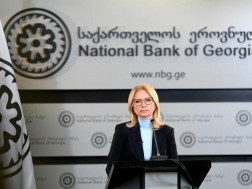On March 13, 2024, the Monetary Policy Committee of the National Bank of Georgia decided to reduce the Monetary Policy Rate (refinancing rate) by 0.75 percentage points. The policy rate now stands at 8.25 percent.
In Georgia, a low inflation environment is sustained and headline inflation is well below the target. In February, the overall price level increased by 0.3 percent annually, while the core inflation stood at 2.4 percent. It is noteworthy that low inflation is a result of both domestic, as well as external factors. On the one hand, the key driving factor of lower inflation is the declining prices on domestically produced products (2.4 percent) resulting from tight monetary policy and slowdown in inflation expectations. On the other hand, price pressures stemming from external shocks, such as those caused by the war and the pandemic, have significantly weakened contributing to a lower overall inflation rate. At the same time, the real effective exchange rate keeps its strong position, which supports the inflation on imported goods to stay at a low level. The low inflation environment helps the inflation expectations decline, which further significantly lowers the inflationary risks in the medium term. Other things equal, inflation is expected to remain below the target of 3 percent at the beginning of 2024, while stabilizing close to it in the medium term.
Despite the existing inflationary risks, their severity has decreased. One of the major inflationary risks is the heightened prices on international transportation due to ongoing Red Sea tensions. The hostilities in this region are still ongoing; however, shipment costs, after surging in December and January, declined to some extent in February. Meanwhile, as it was expected, local economic activity is gradually approaching its potential trend. According to the preliminary estimates, in January, annual economic growth equaled 5.8%, which indicates the neutralization of demand-driven inflationary pressures. According to the National Bank of Georgia’s projections, with the gap between economic activity and its pre-pandemic trend being fully closed, it is anticipated that the growth of economic activity in 2024 will gradually normalize around that of potential GDP.
In light of the above-mentioned factors and the analysis of the current stance, the National Bank of Georgia continues exit from its tight monetary policy stance, reducing the policy rate by 0.75 percentage points to 8.25 percent. Nevertheless, should factors amplifying inflation expectations and external sector risks become apparent, other things equal, maintaining the current tight stance for a longer period or further policy tightening may become necessary.
The NBG continuously monitors the developments in the economy and financial markets and will use all available tools to ensure price stability.
















